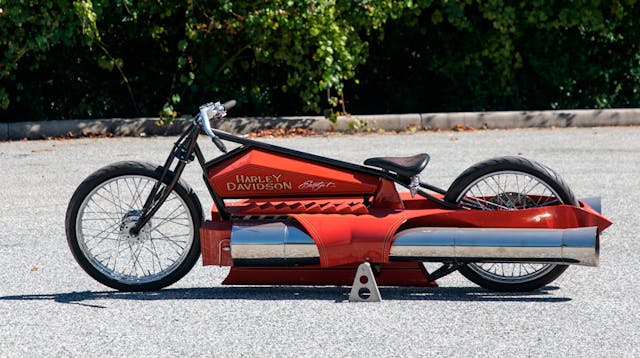Embrace your inner Wile E. Coyote with this jet-powered motorcycle
Bob Maddox has been dabbling with pulsejets for more than 20 years, and initially he was interested in strapping one to his chest so he could cover more ground when skydiving. His thirst for adventure has led him to experiment with all sorts of pulsejet-powered projects along the way, and one of his most beautiful creations, this twin-jet motorcycle, is headed to Mecum’s Kissimmee sale in January.
The motorcycle looks like a stripped-down board-track racer collided with an ACME catalog in the best possible way. The faceted tank, gently curved heat shield, and long, rigid chassis are highlighted by the brightly polished stainless steel pulsejets that are mounted on either side. Those twin engines provide about 250 pounds of thrust, more than enough for spirited acceleration.

You might recognize this motorcycle, as it did get a lot of attention when it was built, but you might have also seen Maddox with another one of his pulsejet-powered creations. Maddox has crafted thrust-powered vehicles of all kinds, from lakester to skateboard, and a couple of his go-kart runs have gone viral. His most popular selfie-stick-filmed video shows him piloting a triple-jet kart at about 60 mph on a northern California dry lake bed, grinning like a kid on Christmas morning as his flowing beard wraps around his helmet and the jets glow an alarming shade of orange, then yellow, then white in the sunset light.
Maddox’s latest creations look like they use a different, valveless design of pulsejet, but his earlier versions, like the ones on this motorcycle, are also very simple pulsejets with very few moving parts. These twin pulsejets use spring steel reed valves over a CNC-milled billet aluminum block. When combustion occurs the reed valves close, forcing the expanding gases to escape rearward as thrust, and the flame goes out. The frequency of combustion varies based on the resonance of the pipe which uses the pulse of the previous combustion to pull in air for the next cycle, so whether it’s at idle or full-throttle, the drone of the engine doesn’t change much, but the power output certainly will. Here’s video of a pre-beard Maddox testing the cycle.
The modular design that Maddox created for his reed valves allows for stacks of the reeds to be added for more airflow to match the size of the jet. The jets are started with a bit of compressed air to get the air flowing and a spark plug running a powerful coil keeps the pulses going. Pulsejets create a good amount of thrust for their weight and make a fantastic sound, but they’re not at all fuel efficient. However, with hardly any parts to wear or break, the few gallons it chugs in gasoline would be a small price to pay for such a unique piece of machinery.





This is a really stupid, dangerous idea and I want one s-o-o-o-o bad I can taste it! 😎